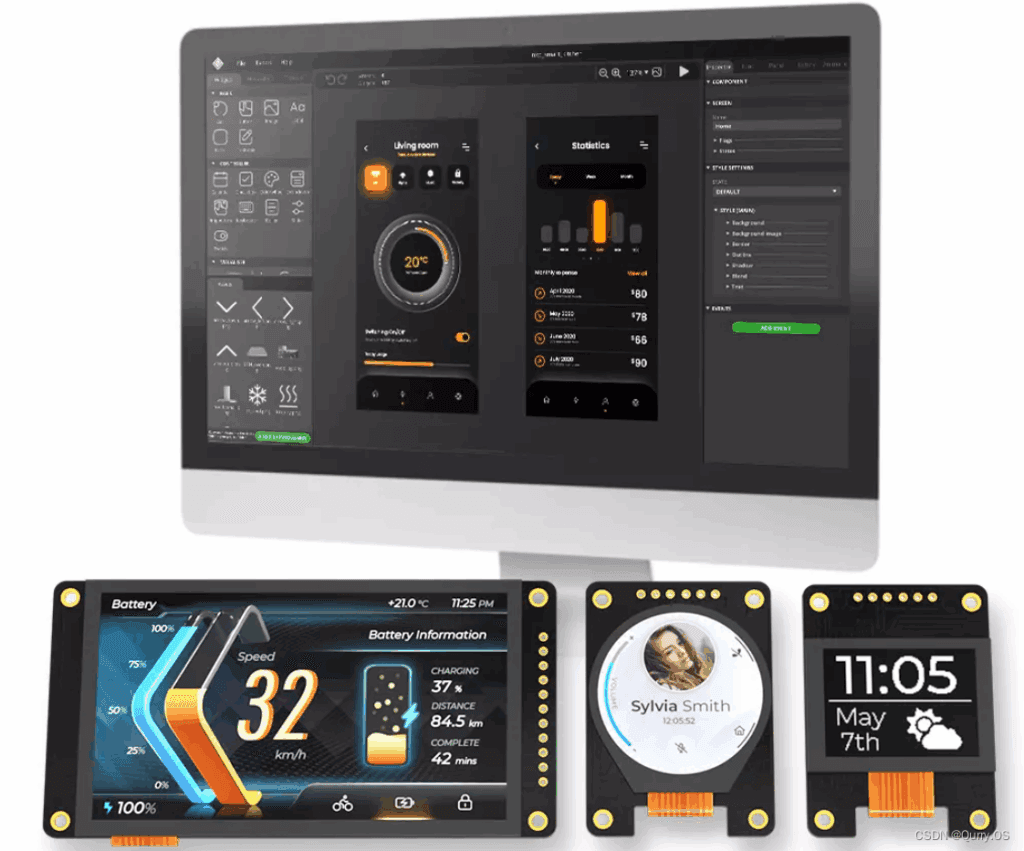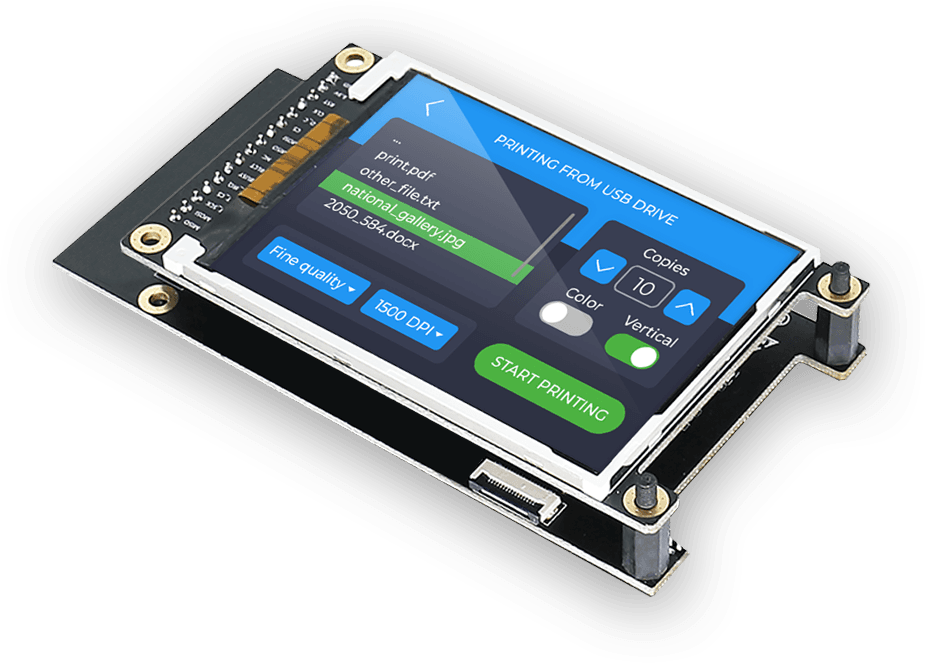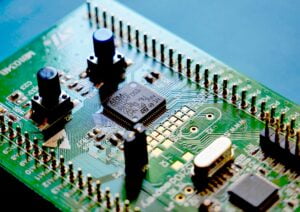A Practical Guide for Engineers: From Lightweight Graphics Library to Efficient Human-Machine Interface Development, Analyzing the Application Value of LVGL in Embedded Systems.
1. What is LVGL? A Lightweight Embedded Graphics Library for HMI Development
LVGL, or Light and Versatile Graphics Library, is widely used in embedded GUI development due to its lightweight nature. Written in C, it features low resource usage, strong portability, and rich functionality, making it widely used in HMI development for industrial control, smart home, medical devices, and more.
Compared to traditional graphics libraries, LVGL performs exceptionally well in resource-constrained environments, enabling smooth graphical interfaces on low-power microcontrollers. It supports various operating systems and hardware platforms, including FreeRTOS, Zephyr, RT-Thread, and bare-metal systems, offering strong adaptability.

2. Core Advantages of LVGL
2.1. Lightweight and Efficient, Suitable for Resource-Constrained Devices
For embedded HMI development, the LVGL GUI library was designed to address the resource limitations in graphical interface development for embedded devices. Its core library requires only tens of KB of memory to run basic graphical interfaces, making it suitable for devices with limited memory and processor performance.
2.2 Rich Controls and Animation Support
LVGL provides a wealth of GUI controls, such as buttons, sliders, charts, and lists, to meet most HMI development needs. Its built-in animation engine supports smooth transitions and dynamic effects, enhancing user experience.

2.3. Highly Customizable
As an open-source project, LVGL allows developers to deeply customize according to project needs. Whether it's control styles, layouts, or functional extensions, everything can be flexibly adjusted to meet the personalized needs of different application scenarios.
2.4. Cross-Platform Support, Strong Portability
LVGL supports multiple operating systems and hardware platforms, including popular ARM Cortex-M series, ESP32, STM32 microcontrollers, and embedded Linux platforms. Its excellent portability allows developers to quickly deploy and migrate projects across different platforms.
3. Application Scenarios of LVGL in HMI Development
LVGL demonstrates strong adaptability in HMI development across various industries. Here are some typical application scenarios:
3.1. Industrial Control Interfaces
In the industrial automation field, LVGL is widely used to develop control interfaces for devices such as PLC panels and CNC machine displays. Its low resource usage and high response speed meet the stability and real-time requirements of industrial equipment.

3.2. Smart Home Control Panels
LVGL is suitable for developing touch panels for smart home devices, such as smart air conditioners and lighting controls. Its rich controls and animation effects enhance user interaction experience.
3.3. Medical Device Display Interfaces
In medical devices, LVGL can be used to develop graphical interfaces for patient monitors and portable diagnostic equipment. Its high customizability and stability ensure reliable operation of medical devices.
4. LVGL's Underlying Architecture and Technical Principles
LVGL achieves high-performance graphical interfaces in resource-constrained embedded environments through its layered decoupling architecture design and platform-independent rendering model. Below is an analysis of its core modules:
4.1 LVGL Architecture Layer Diagram
graph TD App[User Application Layer] --> API[Control API and Style System] API --> GUI[Graphics Rendering Core Module] GUI --> Buffer[Display Buffer Management] GUI --> Input[Input Event Processing] GUI --> Render[Software Renderer] Buffer --> Driver[Display Driver Interface lv_disp_drv_t] Input --> InputDriver[Input Driver Interface lv_indev_drv_t]
4.2 Rendering Mechanism Analysis (Double Buffering vs Partial Refresh)
• Double Buffering: LVGL recommends using two frame buffers. After completing the background drawing, it refreshes the screen at once to avoid tearing and flickering.
• Partial Refresh: Supports clipping regions, refreshing only the changed parts of the interface, significantly reducing memory and CPU usage.
• Color Depth Support: Supports 1/8/16/32-bit color depth configurations, allowing developers to choose performance/quality trade-offs based on hardware capabilities.
???? On resource-constrained platforms like Cortex-M4 or ESP32, it is generally recommended to enable partial refresh and use DMA2D or SPI DMA for hardware-accelerated transmission.
4.3 Input Event Handling System
LVGL supports various input devices:
• Capacitive/Resistive Touchscreens (via I²C, ADC, FT5x06 drivers)
• Encoders (knobs)
• Key matrices
• Touch gestures (swipe, long press, double-click, etc.)
The event mechanism uses the event_cb mechanism to handle various event types:
| Event Type | Description |
|---|---|
| LV_EVENT_PRESSED | Pressed |
| LV_EVENT_CLICKED | Clicked |
| LV_EVENT_LONG_PRESSED | Long Pressed |
| LV_EVENT_RELEASED | Released |
| LV_EVENT_VALUE_CHANGED | Value Changed (Slider/Switch) |
This mechanism makes HMI behavior processing logic closer to the event-driven paradigm of desktop development.
5. Technical Comparison of LVGL with Other HMI Graphics Libraries
Developers often compare LVGL with emWin, TouchGFX, AWTK, etc. Here is a technical feature comparison:
| Feature | LVGL | emWin | TouchGFX | AWTK |
|---|---|---|---|---|
| Open Source License | MIT (Fully Open Source) | Commercial Closed Source (SEGGER) | ST Official Maintenance, Partially Closed Source | LGPL |
| Rendering Architecture | Software Rendering + Optional GPU | Strong Hardware Optimization | Needs CubeMX Configuration | Based on C Object Model |
| UI Toolchain | SquareLine Studio | GUIBuilder | TouchGFX Designer | AWTK Studio |
| Cross-Platform Support | ✅ Bare-metal/RTOS/Linux/Windows | ❌ Primarily Embedded | ❌ Highly Customized for STM32 | ✅ Linux/UI Framework |
| RAM Usage (Simple UI) | 40~60KB | 80~100KB | ≥100KB | 70~100KB |
| Hardware Dependency | Low (Mainly Software Rendering) | Highly Bound to SEGGER | Highly Dependent on STM32 | Medium |
???? Summary: LVGL is currently the only GUI framework that is comprehensively balanced in terms of lightweight, openness, cross-platform support, and engineering tool completeness, making it very suitable for small to medium-sized embedded projects, mass production products, or domestic MCU platforms.
6. Value of LVGL in Engineering Practice
6.1 Compatibility with Bare-Metal and Various RTOS
LVGL does not rely on dynamic memory allocation (configurable) and provides task scheduling hooks, compatible with:
• FreeRTOS
• RT-Thread
• Zephyr
• AliOS Things
• CMSIS-RTOS
• Even bare-metal main loops
This means it can "run bare" on most chip platforms like STM32, GD32, ESP32, NXP.
6.2 Rapid GUI Development with SquareLine Studio for LVGL Projects
SquareLine Studio is the official LVGL visual UI editor, supporting:
• Drag-and-drop controls, layout management, animation configuration
• Automatic generation of .c/.h files + Assets packaging
• Direct integration with PlatformIO / STM32CubeIDE projects
For teams looking to quickly produce demos or interactive UIs, this significantly lowers the entry barrier.
6.3 LVGL on ESP32: Lightweight GUI for Wireless HMI Applications
LVGL runs exceptionally well on ESP32, making it one of the most popular combinations for embedded GUI and wireless HMI development. With its dual-core processor, DMA-friendly memory architecture, and built-in Wi-Fi/Bluetooth, ESP32 offers an ideal platform for responsive, low-cost graphical interfaces.
Thanks to the official support from LVGL in the ESP-IDF environment, developers can quickly integrate UI components into IoT and smart control devices — even with limited RAM and flash.
Why ESP32 + LVGL is a Top Choice for Embedded GUI:
- ✅ Low-cost, high-performance MCU with dual-core Xtensa processors
- ✅ Built-in Wi-Fi and Bluetooth, perfect for wireless HMI interfaces
- ✅ LVGL fully supports ESP32 via PlatformIO and ESP-IDF
- ✅ Compatible with SquareLine Studio, enabling visual UI design
- ✅ DMA + SPI optimization options for smooth screen refresh
- ✅ Widely used in smart thermostats, wall panels, handheld devices, and more Pro Tip: For optimal performance, enable partial refresh mode and leverage SPI DMA when interfacing with TFT or IPS displays. Use double-buffering for flicker-free rendering on higher-resolution panels.
7. Application Cases of LVGL in Real Projects
LVGL is not a "laboratory project" but has been widely applied in many high-stability scenarios. Here are some representative case studies:
| Application Industry | Device Type | Deployment Platform | UI Development Method |
|---|---|---|---|
| Industrial Automation | PLC HMI Screen, Injection Molding Machine Panel | STM32F4 / RT-Thread / FreeRTOS | LVGL + SquareLine Studio |
| Smart Home | Smart Water Heater, Wall Touch Panel | ESP32 / AliOS Things | LVGL + Custom Components |
| Portable Medical Devices | Glucometer, Wearable Monitor | GD32 + Bare-metal | LVGL + Handwritten Interface |
| Education/Development Tools | STM32 UI Development Board, Raspberry Pi UI Project | Linux Framebuffer | LVGL + Python Bindings |
???? Note:
• In industries with high requirements for power consumption and stability, LVGL is considered one of the most reliable open-source GUI engines due to its no GC, no multi-thread dependency, low frame buffer characteristics.
• In start-up teams and domestic MCU platforms, it has also quickly gained popularity due to its comprehensive documentation and friendly open-source license.
8. Performance Optimization and Porting Suggestions
To achieve optimal performance on different platforms, consider the following engineering optimization points:
8.1 Buffer Configuration Suggestions
| Type | Scenario | Recommended Strategy |
|---|---|---|
| Single Buffer | Extremely Small Memory Platforms (<128KB RAM) | Use simplified version of lv_disp_flush() |
| Double Buffer | Standard Cortex-M4 / M7 Platforms | Configure 2x display buffer to improve refresh efficiency |
| DMA Acceleration | With LCD Interface DMA2D / SPI DMA | Use memcpy DMA with screen region |
8.2 Tick Driving Strategy
• By default, use timer interrupts + lv_tick_inc() to drive animations and task processing.
• If using FreeRTOS or similar kernels, it is recommended to call lv_task_handler() after vTaskDelay() to avoid context conflicts.
• Integrating VSync can reduce screen flickering issues.
8.3 Common Porting Issues
| Issue | Cause | Solution |
|---|---|---|
| Display Tearing or Flickering | Unsynchronized Screen Refresh | Use double buffering + line buffer technology |
| Chinese Characters Not Displaying | Font Library Not Enabled | Enable LV_USE_FONT_DEJAVU_16_PERSIAN_HEBREW or customize Chinese fonts |
| Touch Not Responding | Event Not Registered | Check indev driver callback and polling interval |
9. Deployment Suggestions and Platform Compatibility
In the embedded graphics library landscape, LVGL stands out as the go-to choice for efficient and reliable HMI development. It is supported by the community on the following mainstream deployment platforms:
| System Platform | Supported | Recommended Toolchain |
|---|---|---|
| STM32 (CubeMX) | ✅ | STM32CubeIDE + CMake |
| ESP32 | ✅ | ESP-IDF + PlatformIO |
| NXP RT Series | ✅ | MCUXpresso SDK |
| Linux + Framebuffer | ✅ | GCC + SDL/DirectFB |
| Zephyr RTOS | ✅ | West Build + CMake |
| RT-Thread | ✅ | RT-Thread Studio |
| Windows / macOS Simulation | ✅ | MinGW / SDL2 / Qt |
???? Tip: You can even use LVGL + WebAssembly to compile the UI to run in a browser! This is suitable for online demonstrations, simulators, or cloud configuration platforms.
Whether you’re building an HMI for industrial control, smart homes, or medical devices, LVGL and tools like SquareLine Studio offer a complete and efficient GUI development experience — especially for platforms like ESP32 and STM32. For anyone seeking a lightweight yet powerful embedded graphics library, LVGL is hard to beat.
???? Recommended Reading
If you're interested in embedded GUI frameworks like LVGL, HMI here are some next reads to help you dive deeper:
???? Deep Dive into LVGL: From Lightweight Graphics to Smooth Human-Machine Interaction
???? HMI Development in 2025: Tools, Touchscreens, and Programming Stacks Explained

